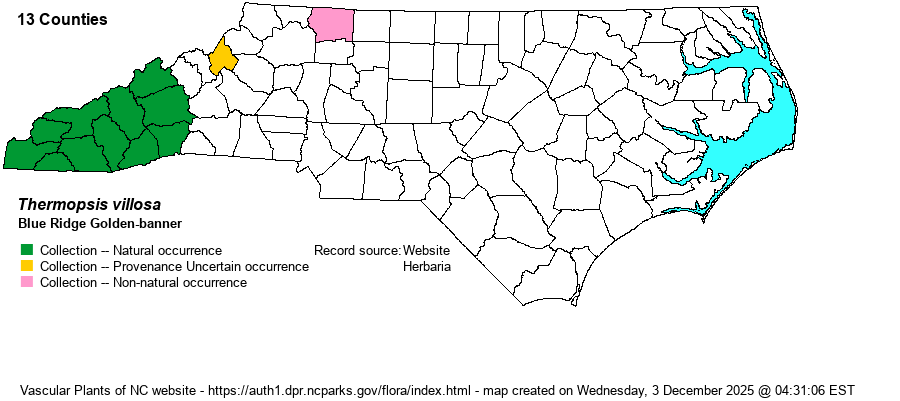| Author | (Walter) Fernald & Schubert | |
| Distribution | Ranges throughout the southern 45% of the Mountains, northeast to Madison and Henderson counties. Records northeast to Avery and Surry counties may well be not natural, and certainly the latter is not natural, as the Digital Atlas of the Virginia Flora website considers the few records from that state as not native.
This species has a very small and tight range only from southwestern NC and parts of TN, south only to northern GA. In fact, it is not even known yet from SC, and thus native only in NC, TN, and GA. | |
| Abundance | Infrequent in the NC Mountains north to Madison and Henderson counties. Probably somewhat rare in the northeastern counties along the edge of the range, but not a rare species (at least formerly) in some counties. Information from mountain botanists indicate that the species has declined in recent years, such that the NCNHP has moved the State Rank to a concerning S1S2, despite natural records from at least 10 counties. Data from iNaturalist seem to suggest that S1S2 is too conservative, and a suggested rank of S2 is better. The NCNHP is now tracking the species as Significantly Rare. | |
| Habitat | This is the only member of the genus in NC that is not found in dry or rocky habitats. This species favors wooded margins and roadbanks, or in openings in woods, but where mesic to somewhat moist, generally in partial shade. It can occur in floodplains and in some slightly disturbed places and is not normally found in deep shade of rich forests. | |
| Phenology | Blooms in May and June, and fruits from July to September. | |
| Identification | This is a rather tall and elegant species, normally unbranched and reaching a height of 3-4 feet tall, at times higher. The stem is quite hairy, and the scattered leaves up the stem are fairly large; each of the 3 leaflets is 2.5-3 inches long and about 1.5 inches wide. The species has quite large stipules at the base of the leaves, and these can be 2 inches long and clasping the stem. The flowering stalk is normally terminal and very "straightly" erect, reaching about 8 inches tall with dozens of bright yellow flowers crowding the stalk, each being about 3/5-inch long. When in bloom, especially when a group of plants is found, the species is impossible to miss, owing to the quite tall "steeple" of a few dozen yellow flowers. Even the large leaflets with the quite large clasping stipules are easily spotted. (These flowers and leaves may be reasons that this species is widely planted in the Southeast beyond the natural range.) Thankfully, you have a chance to see natural populations of this fine species in some of the southwestern counties, by driving back roads in forested areas. | |
| Taxonomic Comments | None
| |
| Other Common Name(s) | Aaron's-rod, Carolina Lupine, Carolina Bush-pea, Hairy False Lupine, Hairy Bush-pea, Blue Ridge Buckbean. This species has a remarkable array of common names in usage, none even close to unanimous! NatureServe, which the NCNHP follows as it is part of the NatureServe Network, uses Hairy False Lupine. It appears that the majority of the Eastern species of Thermopsis go by some form of "Golden-banner" as the common name. To be consistent, this website will use one of Weakley's (2018) two common names -- Blue Ridge Golden-banner for the common name for this website, to avoid using an idiosyncratic name such as Aaron's-rod, or a misleading name such as a bush-pea, lupine, or buckbean. | |
| State Rank | S1S2 [S2] | |
| Global Rank | G3? | |
| State Status | SR-T | |
| US Status | | |
| USACE-agcp | | |
| USACE-emp | | |

